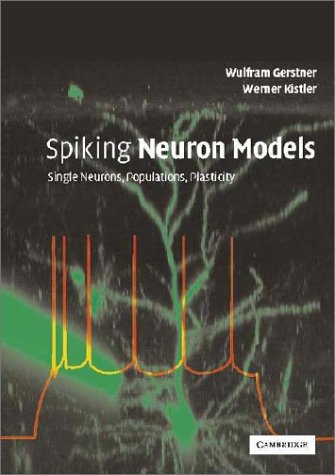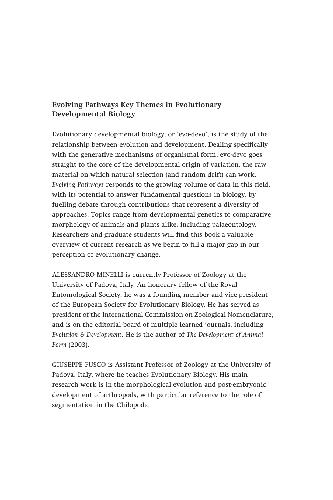Wulfram Gerstner, Werner M. Kistler9780521813846, 0-521-81384-0
Table of contents :
1.8 Summary……Page 0
Spiking Neuron Models Single Neurons, Populations, Plasticity……Page 5
Contents……Page 7
1. Introduction……Page 15
1.1 Elements of Neuronal Systems……Page 17
1.2 Elements of Neuronal Dynamics……Page 21
1.3 A Phenomenological Neuron Model……Page 24
1.4 The Problem of Neuronal Coding……Page 31
1.5 Rate Codes……Page 34
1.6 Spike Codes……Page 39
1.7 Discussion: Spikes or Rates?……Page 44
1.8 Summary……Page 47
I. Single Neuron Models……Page 49
2. Detailed Neuron Models……Page 51
2.1 Equilibrium potential……Page 53
2.2 Hodgkin-Huxley Model……Page 56
2.3 The Zoo of Ion Channels……Page 63
2.4 Synapses……Page 72
2.5 Spatial Structure: The Dendritic Tree……Page 75
2.6 Compartmental Models……Page 83
2.7 Summary……Page 87
3. Two-Dimensional Neuron Models……Page 89
3.1 Reduction to two dimensions……Page 91
3.2 Phase plane analysis……Page 97
3.3 Threshold and excitability……Page 105
3.4 Summary……Page 112
4. Formal Spiking Neuron Models……Page 114
4.1 Integrate-and-fire model……Page 116
4.2 Spike response model (SRM)……Page 124
4.3 From Detailed Models to Formal Spiking Neurons……Page 140
4.4 Multi-compartment integrate-and-fire model……Page 155
4.5 Application: Coding by Spikes……Page 162
4.6 Summary……Page 167
5. Noise in Spiking Neuron Models……Page 169
5.1 Spike train variability……Page 172
5.2 Statistics of spike trains……Page 175
5.3 Escape noise……Page 189
5.4 Slow noise in the parameters……Page 198
5.5 Diffusive noise……Page 200
5.6 The subthreshold regime……Page 212
5.7 From diffusive noise to escape noise……Page 217
5.8 Stochastic resonance……Page 221
5.9 Stochastic firing and rate models……Page 225
5.10 Summary……Page 230
II. Population Models……Page 232
6. Population Equations……Page 234
6.1 Fully Connected Homogeneous Network……Page 237
6.2 Density Equations……Page 241
6.3 Integral Equations for the Population Activity……Page 256
6.4 Asynchronous firing……Page 266
6.5 Interacting Populations and Continuum Models……Page 275
6.6 Limitations……Page 282
6.7 Summary……Page 284
7. Signal Transmission and Neuronal Coding……Page 286
7.1 Linearized Population Equation……Page 288
7.2 Transients……Page 300
7.3 Transfer Function……Page 308
7.4 The Significance of a Single Spike……Page 315
7.5 Summary……Page 326
8. Oscillations and Synchrony……Page 328
8.1 Instability of the Asynchronous State……Page 330
8.2 Synchronized Oscillations and Locking……Page 339
8.3 Oscillations in reverberating loops……Page 349
8.4 Summary……Page 358
9. Spatially Structured Networks……Page 360
9.1 Stationary patterns of neuronal activity……Page 362
9.2 Dynamic patterns of neuronal activity……Page 374
9.3 Patterns of spike activity……Page 379
9.4 Robust transmission of temporal information……Page 386
9.5 Summary……Page 393
III. Models of Synaptic Plasticity……Page 395
10. Hebbian Models……Page 396
10.1 Synaptic Plasticity……Page 398
10.2 Rate-Based Hebbian Learning……Page 404
10.3 Spike-Time Dependent Plasticity……Page 411
10.4 Detailed Models of Synaptic Plasticity……Page 419
10.5 Summary……Page 431
11. Learning Equations……Page 433
11.1 Learning in Rate Models……Page 435
11.2 Learning in Spiking Models……Page 450
11.3 Summary……Page 463
12. Plasticity and Coding……Page 465
12.1 Learning to be Fast……Page 467
12.2 Learning to be Precise……Page 470
12.3 Sequence Learning……Page 477
12.4 Subtraction of Expectations……Page 483
12.5 Transmission of Temporal Codes……Page 487
Summary……Page 498
Bibliography……Page 499
Index……Page 540
Footnotes……Page 555
Book: Spiking Neuron Models by W. Gerstner and W.M. Kistler……Page 1
Preface: Spiking Neuron Models by W. Gerstner and W.M. Kistler……Page 3







Reviews
There are no reviews yet.